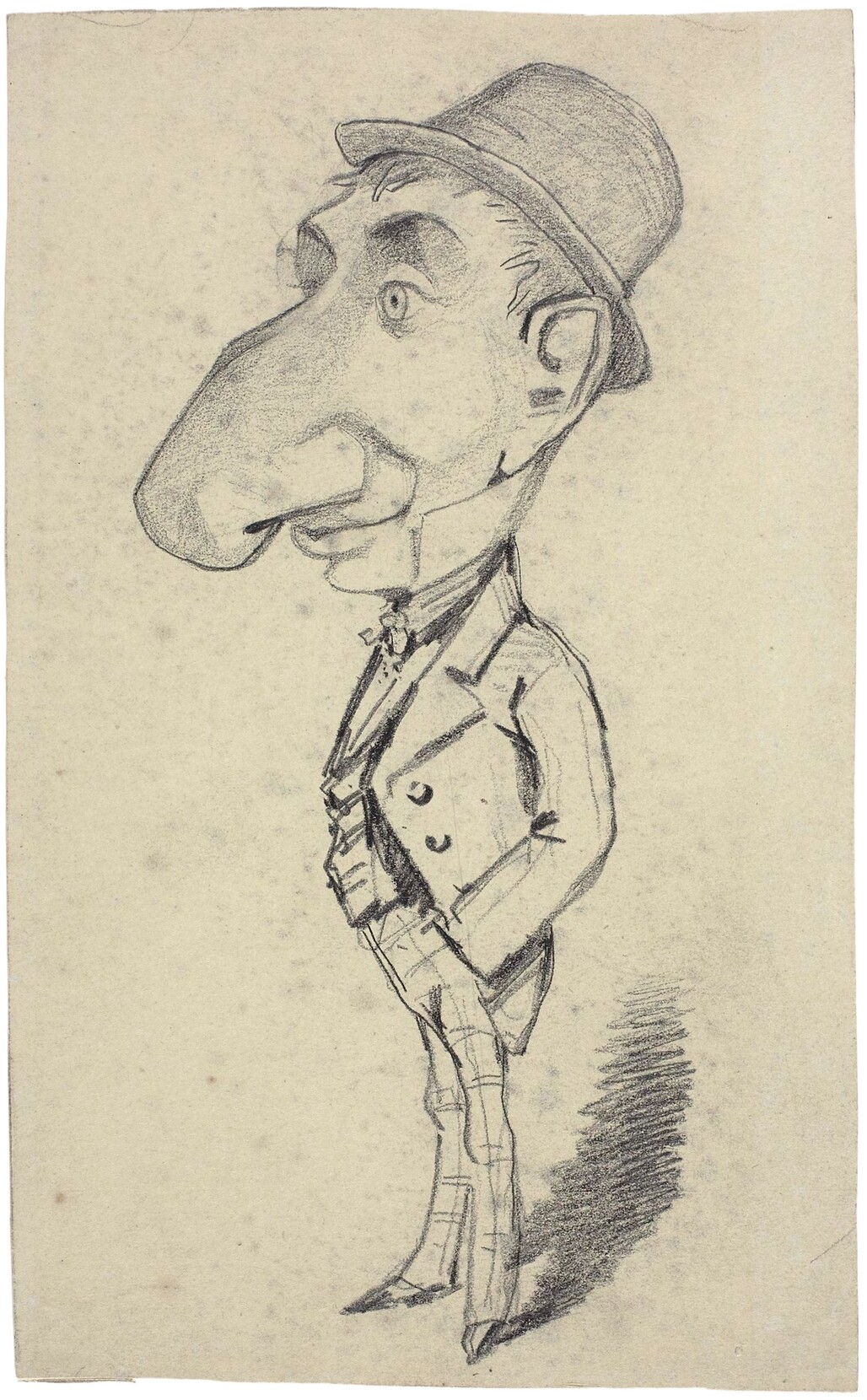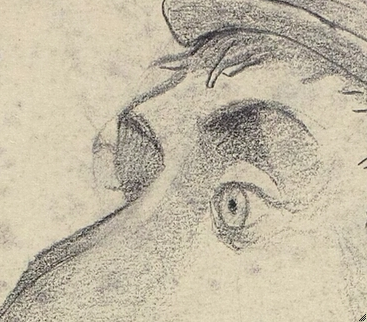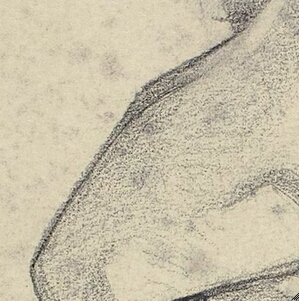Cat. 8
Caricature of a Man with a Large Nose
1855/56
Graphite on greenish-gray wove paper; 248 × 152 mm
The Art Institute of Chicago, Mr. and Mrs. Carter H. Harrison Collection, 1933.895
Technical Report
Technical Summary
Claude Monet created Caricature of a Man with a Large Nose with soft [glossary:graphite] on a slightly textured, greenish-brown [glossary:wove] paper, utilizing most of the sheet. From the layout of the composition, it appears that he worked out the figure with light, quick strokes of graphite, followed by darker, broader lines to more fully establish the form. The side of the graphite was used to carefully model the man’s face and create broad passages of tone in his hat and hair. Shadows were established in the figure’s body using dark, thick strokes of graphite.
Media and Support
Support Characteristics
Primary paper type
Greenish-brown, moderately thick, slightly textured wove paper.
Furnish
Uniform with a few fiber inclusions.
Formation
Even.
Other characteristics
The edges are all trimmed irregularly. The bottom edge has several paper slivers from when cuts were started and then stopped.
Dimensions
248 × 152 mm
Preparatory Layers
No artistic surface alterations or coatings are visible in normal conditions, under [glossary:UV] illumination, or under magnification. Under UV illumination, there is a pale-yellow visible-light [glossary:fluorescence] overall on the paper surface that is characteristic of a light gelatin surface [glossary:sizing].
Media Characteristics
The composition was drawn using the dull tip of a soft graphite pencil to establish the outline and the form of the figure. The artist first quickly sketched in the forms with light graphite lines, and then he selectively reinforced them with darker, thicker strokes. Tonal effects in the face were created utilizing the side of the graphite with light pressure to fill in the broad areas of shading and modeling. There is a slight indentation in the paper [glossary:support] where the artist applied more pressure with his stroke to define the outline of the hat and the tip of the nose. The tonal effects of the body and shadow cast by the body were created with diagonal lines drawn with the side of the graphite in a back-and-forth motion. Monet further detailed the caricature by adding a pattern to the pants with simple perpendicular lines.
Compositional Development
The composition was drawn directly onto the paper support. There is minor reworking of the figure’s head at the nose and near the proper right eye (fig. 8.1). The artist changed the location of the proper right eye and angled the forehead back to make the head slightly smaller. With magnification there is no evidence of erasure or rubbing in the area of alteration. The artist’s initial sketch was so faint that it did not affect the final rendering.
The bridge of the sitter’s nose was slightly elevated and exaggerated. The initial outline can be seen below this area of shading. The revision may have occurred late in the drawing stage because the line is dark, which suggests that the artist had been content with the initial sketch, causing him to reinforce the newer line with a longer darker stroke (fig. 8.2). Monet may have applied more shading than initially intended in order to hide the dark line of his preliminary sketch.
Surface Treatment
No fixatives or coatings are visible in normal conditions, under UV illumination, or under magnification.
Condition History
The drawing is in very good condition. There is light surface soiling and discoloration overall. There are stray graphite markings along the top edge and at the lower right corner. Discoloration from light exposure is visible throughout except along the very edges of the sheet, where it was protected from the light by a former window mat. A faint brown [glossary:mat burn] line is visible along the right and lower edges. There are several brown [glossary:foxing] spots throughout the sheet on the recto and verso. With UV-induced visible fluorescence, hundreds of foxing spots that are not visible in normal conditions fluoresce yellow. There is a vertical, incised line 70 mm long running through the figure’s jacket and legs. The lower left and right corners have strong diagonal creases. The edges are all trimmed irregularly. The bottom edge has several paper slivers. On the verso, at the center left edge, the paper tone is lighter, with paper abrasion and thinning.
The drawing was treated in 2005 to reduce the appearance of the foxing spots on the recto.
Dawn Jaros
Provenance
Alfred Dusseuil (1878–1927), Paris.
Sold by Henri Cottereau, Paris, to Carter H. Harrison (1860–1953), Chicago, winter 1927–28.
Given by Carter H. Harrison to the Art Institute of Chicago, 1933.
Selected References
Hugh Edwards, “The Caricatures of Claude Monet,” Bulletin of the Art Institute of Chicago 37, 1 (Jan. 1943), p. 71.
Charles Merrill Mount, Monet, a Biography (Simon & Schuster, 1966), p. 396.
Daniel Wildenstein, Claude Monet (Fratelli Fabbri, 1971), p. 92 (ill.), no. 45.
Rodolphe Walter, “Claude Monet as a Caricaturist: A Clandestine Apprenticeship,” trans. Eric Young, Apollo 103 (June 1976), p. 489.
Harold Joachim and Sandra Haller Olsen, French Drawings and Sketchbooks of the Nineteenth Century, vol. 2 (University of Chicago Press, 1979), p. 71, no. 4B5.
Daniel Wildenstein, Claude Monet: Catalogue raisonné, vol. 5, Supplément aux peintures; Dessins: Pastels; Index (Wildenstein Institute, 1991), p. 144, no. D492 (ill.).
Ann Waldron, Claude Monet: First Impressions (Abrams, 1991), pp. 9 (ill.), 90.
Marianne Alphant, Claude Monet: Une vie dans le paysage (Hazan, 1993), p. 62.
Sandy Brooke, Hooked on Drawing (Prentice Hall, 1996), p. 266 (ill.).
Ségolène Le Men, Monet (Citadelles et Mazenod, 2010), pp. 39, fig. 27; 40.
Other Documentation
Inscriptions and Distinguishing Marks
Verso
Mark
Location: upper left corner
Method: blue wax crayon
Content: X
Stamp
Location: center
Method: brown ink
Content: The Art / Institute of / Chicago
Mark
Location: lower left edge
Method: graphite
Content: 33.895
Examination Conditions and Technical Analysis
Raking Visible Light
Paper support characteristics identified.
Transmitted Visible Light
Paper mold characteristics identified.
Ultraviolet-Induced Visible Fluorescence (365 nm)
Light-yellow fluorescence observed throughout, along with hundreds of yellow-fluorescing foxing spots.
Binocular Microscopy (80–100x)
Media type/application identified.
Image Inventory
The image inventory compiles records of all known images of the artwork on file in the Imaging Department and in the conservation and curatorial files in the Department of Prints and Drawings at the Art Institute of Chicago (fig. 8.3).



